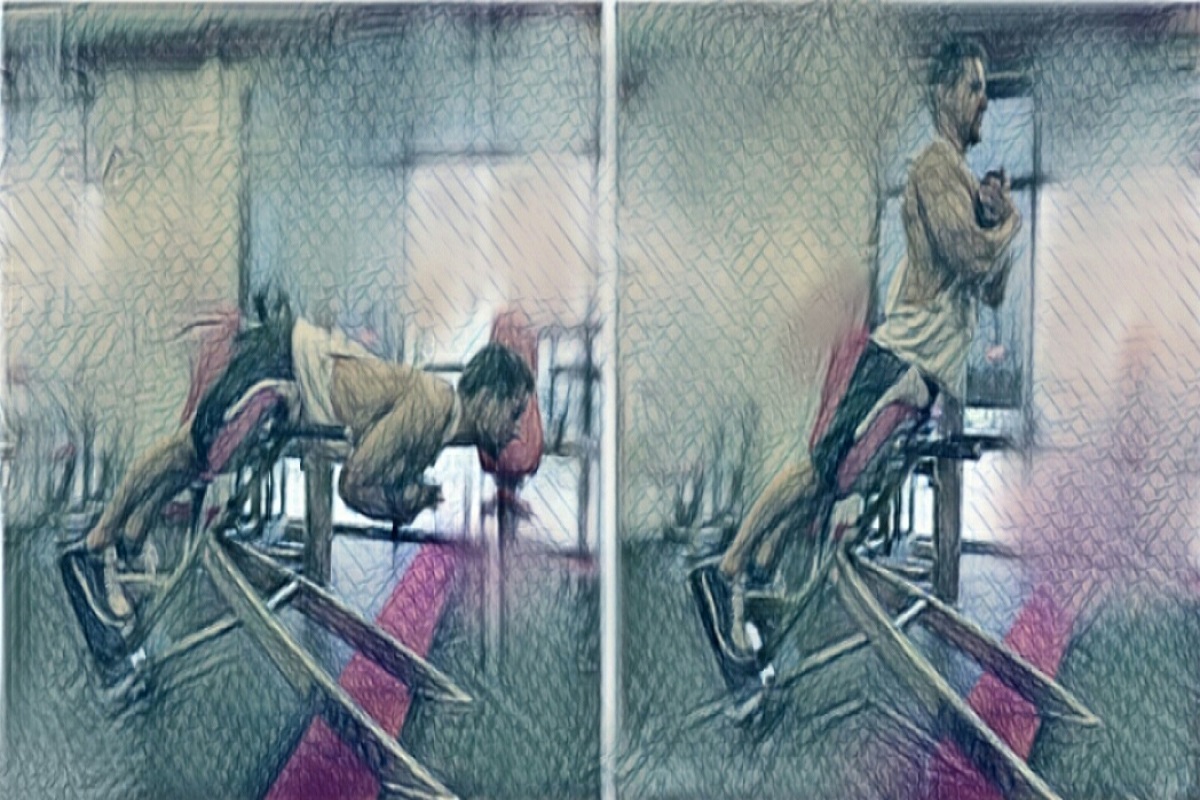A beautiful, sculpted back adds attractiveness to a toned female figure. Men, on the other hand, tend to swing this part of the body as much as possible, giving it a V-shape, ensuring that it bulges with rolling relief muscles and appears wider. Our review of exercises for pumping up your back will be useful to both.
Content
- 1 The most effective back exercises
- 2 Fundamental rules
The most effective back exercises
When drawing up a training program for the back, the same principle works as for other muscle groups: the complex should consist of basic and isolated trainings. The former increase endurance, increase muscle mass, the latter work out each muscle in more detail, forming a relief, increase blood flow, ensuring a full study of muscle groups.
Therefore, first - the rating of the basic exercises. A priori, when training the muscle groups of the chest and back, the arms are involved in one way or another, and absolutely all the trainings presented here develop and strengthen not only the back, but also the muscle groups of the arms and shoulders.
Pull-ups
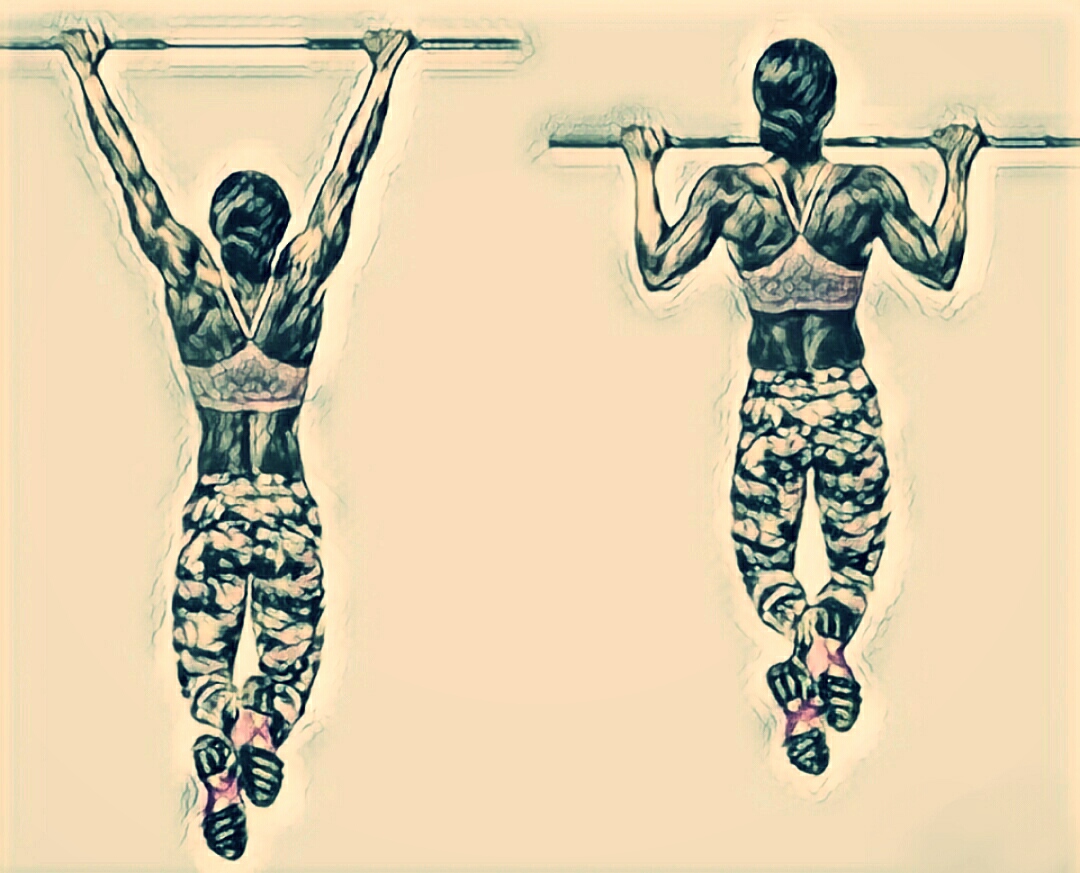
The wide grip option intensively loads almost all muscles: trapezius, large round, lats, as well as triceps and biceps.
The version with a wide reverse grip develops the upper back, but in it you need to carefully monitor the sensations: in a wide grip, the arms are twisted out of the shoulder joints, especially if the exercise is performed with weights. Therefore, in no case should the sensations be brought to painful ones, it is better not to try to tighten the chin to the crossbar, underperforming the pull-up by a quarter, otherwise muscles, joints and ligaments can be injured.
With an average reverse grip, the rhomboid muscle and the rear deltas of the arms are also connected to the listed muscle groups, a silhouette in the shape of the Latin letter V is formed.
The narrow reverse grip of the pull-up shifts the focus to the biceps. With this version of pull-ups, you need to carefully monitor the sensations in your hands, in no case leading to pain. The closer the hands are to each other, the higher the risk of injury to tendons, muscles or joints.
Many, especially girls, avoid pull-ups because of the difficulty of doing it - not everyone will be able to pull up their weight a certain number of times.
For beginners and lovely ladies, there is an option of pull-ups in a special compensator simulator that removes part of the load when pulling up.
You can also use a special elastic band with a weight compensation function, which is suitable for both girls and guys at the initial stage of training. Also suitable for children mastering the youth training complex. The expander is tightened on the horizontal bar with a loop, in which you need to stand with your feet and pull up in the usual way. To decide which one is better to buy, you need to focus on the following selection criteria:
- Characteristics - the expander indicates the weight in kilograms that it can withstand.
- For the price - according to buyers, both budget options and resistance bands from the best manufacturers of sports equipment have proven themselves equally well.However, if the average price of a product is less than 1,000 rubles, it is unlikely that it will last long as a compensator for pull-ups. Inexpensive models are more suitable for isolated exercises for arms and legs, and may simply not support the weight of the athlete.
- According to reviews, you can read what they write about the selected expander who have already bought it, so it will be easier to understand whether its functionality meets your requirements. It will be useful to look at reviews about other models to decide which expander is better to buy.
Technics:
- Hanging on a horizontal bar or a crossbar, while exhaling, pulling the body up to a position where the chin is level with the crossbar;
- A second delay at the top point, return to the starting position.
Advantages:
- Effectively loads the muscle groups of the back and arms;
- Develops endurance;
- Includes stabilizers, neck and abs;
- Can be performed in the gym and at home with a horizontal bar;
- You can constantly progress using weights.
Disadvantages:
- Risk of injury to muscles, joints and tendons if the technique is not followed.
Row of the upper block to the chest

An alternative to pull-ups, performed in a block trainer. The specificity is the same: the wider the grip - the more the back is loaded, the narrower the grip - the more the emphasis shifts to the arms: the biceps, deltas and triceps work.
Performance:
- Sitting in the simulator, arms outstretched above the head hold the projectile, legs are fixed under a special roller-limiter. The back is slightly bent in the lower back, the body is slightly bent back, the shoulder blades are brought together;
- As you exhale, pull the block down to chest level, hold for a second, while inhaling, return to the starting position.
This analogue of pull-ups can also be performed with a reverse grip at different widths, the effect will be the same as with pull-ups. The working weight should be chosen in such a way that you can perform from 10 to 12 repetitions in 3 or 4 approaches - depending on the level of physical fitness.
Important! You cannot hunch over, the arms must be fully extended so as not to injure the elbow joints. All movements should be smooth, you need to lower the block with blades, without deviating strongly backward - this reduces the efficiency of traction.
Advantages:
- The risk of injury is reduced to a minimum;
- The same muscle groups work as with pull-ups in the horizontal bar;
- Works well for the back and neck, giving the latter a static load;
- Suitable for beginners and girls, since the working weight here may be less than the athlete's own weight.
Disadvantages:
- Impossible to do at home.
Row of the upper block for the head
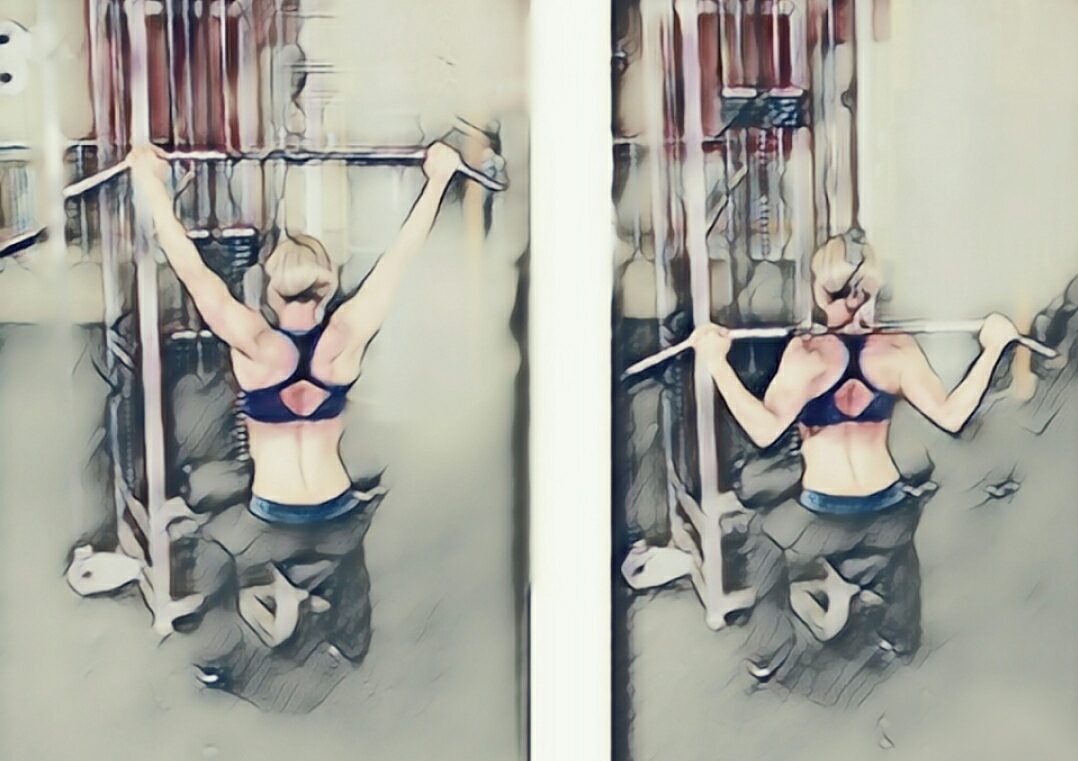
It is recommended to be performed in a set with a pull to the chest in order to maximally and quickly pump up the back and arms, to strengthen the abs. This involves the biceps of the arms and the back deltas (the so-called "wings").
Performance:
- The starting position is the same as in the previous exercise;
- On exhalation, the block descends behind the head to the base of the neck, after a second delay, it returns to its original position.
Important! The bar of the projectile should not fall below the base of the neck, it is optimal to stop the movement when it is slightly higher. The elbows are laid back and to the sides, the movement is made with the back, and not with the hands - they only serve as weight carriers.
Advantages:
- Loads all muscles, including additionally the bottom of the trapezium, giving the back a V-shaped silhouette;
- Suitable for girls and beginners.
Disadvantages:
- It is considered more traumatic for the back and spine than cravings for the chest;
- Cannot be performed at home.
Classic deadlift
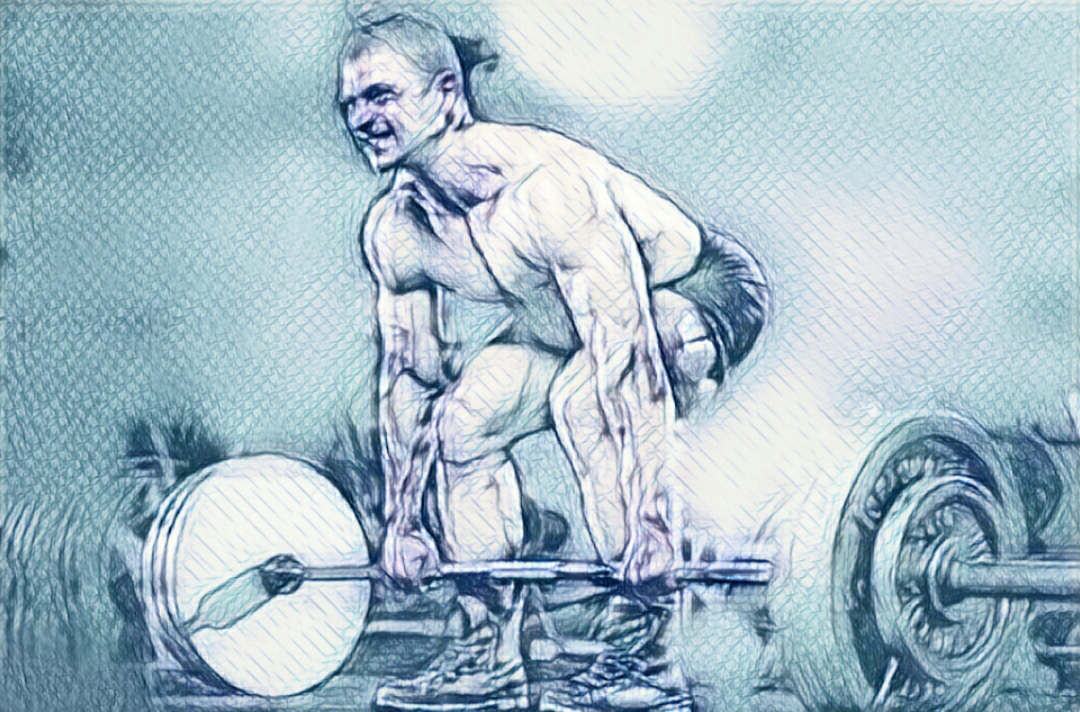
Loads all muscles of the back and arms, as well as the abs, legs and buttocks. Performance:
- Spread your legs shoulder-width apart, bend slightly in the lower back, bar in arms extended along the body;
- On exhalation, the pelvis is pulled back, the knees are bent, the bar of the bar goes along the hips and knees until it touches the floor;
- On inspiration - return to the starting position.
Important! To control the deflection in the lower back, the hands hold the bar wide enough to walk along the body without interfering with movement.It is better to remove the bar from the holders fixed at a height above the knee. If it is not possible to use the holders, and the bar is on the floor, you need to squat with legs apart and an arched back to raise the bar to hip level in outstretched arms.
Advantages:
- It engages all muscle groups, develops endurance.
Disadvantages:
- It is difficult to follow the execution technique, especially for beginners and girls;
- Contraindicated for hernia, spinal injuries and osteochondrosis.
T-bar deadlift
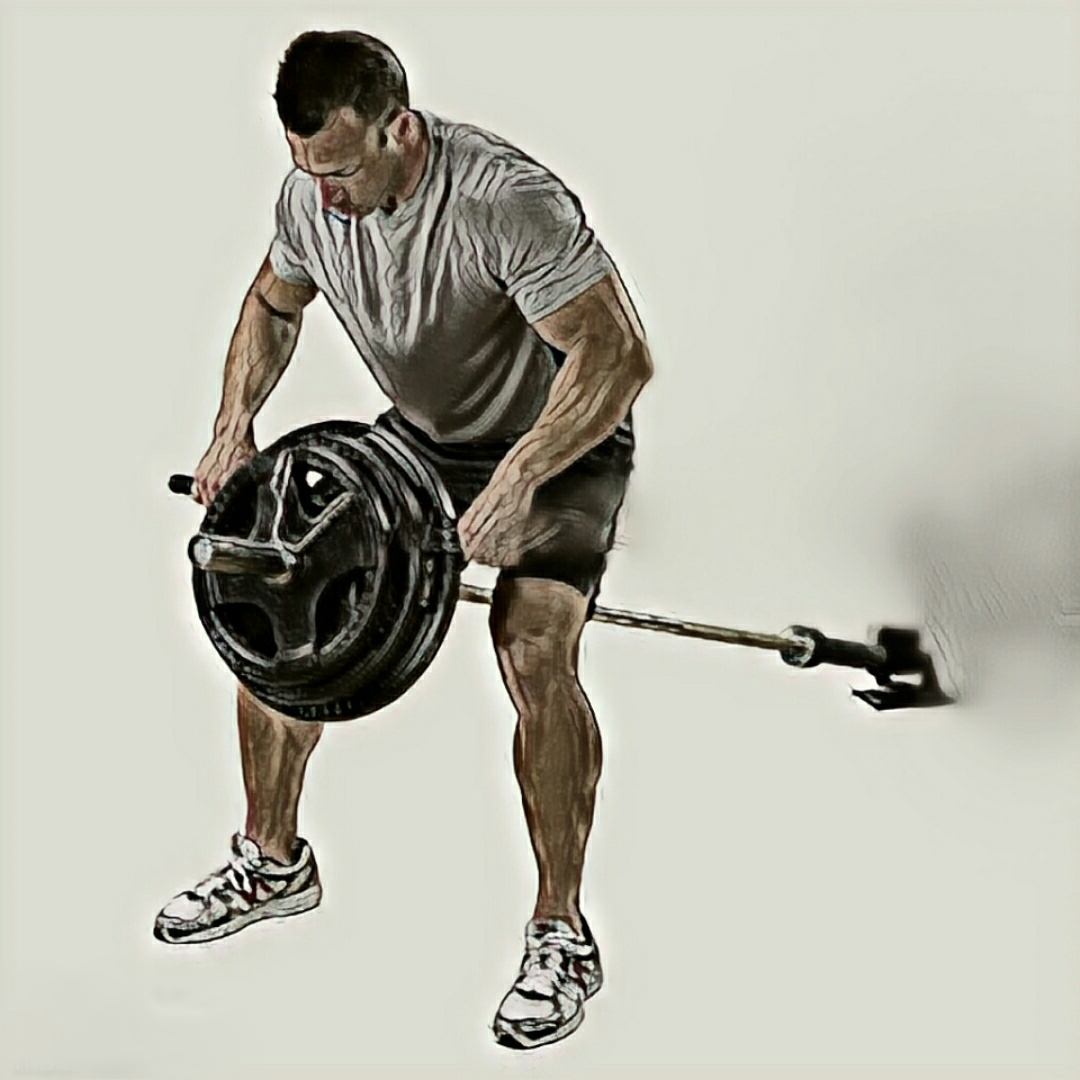
One of the obligatory and favorite exercises of Arnold Schwarzenegger, which got its name due to the similarity of the shell, with the pancake put on it, with the Latin letter "t". It can be performed both in a special simulator and with a regular barbell, it is enough to find a reliable stop for one end of the bar, and hang the working weight on the other.
Performance:
- Legs shoulder-width apart, bent at the knees, forming an obtuse angle, the second obtuse angle forms an inclination of the body, in the hands of a barbell, you can also use a belt or metal holder;
- On exhalation - the thrust of the bar located between the legs to the belt, on inhalation - straightening the arms.
Important! We keep a slight deflection in the lower back, but we should not bend in an arc, the movements are strictly controlled, there should be no jerks. You need to pull the bar not only with your hands, but also with your shoulder blades.
Advantages:
- Effectively works the entire back, including the rear deltas and shoulders.
Disadvantages:
- Failure to comply with the execution technique loads the biceps, due to its overload, the efficiency of the muscle groups is sharply reduced.
Row of the bar to the belt in the slope
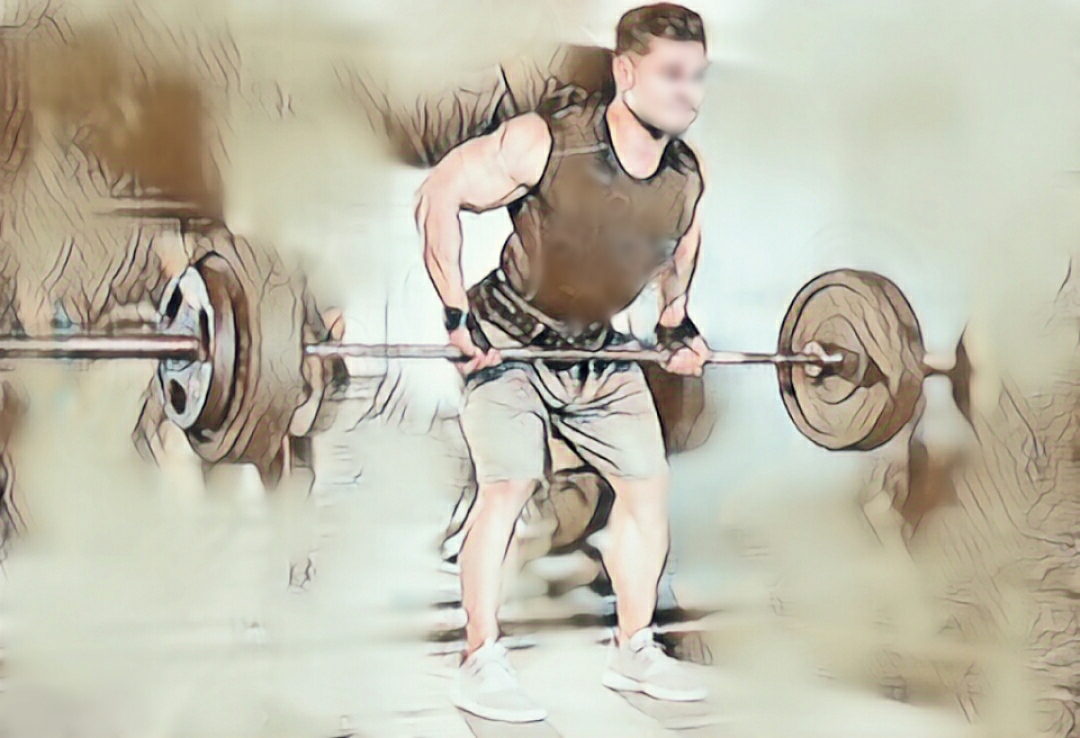
An alternative to T-bar deadlift. Before the development of the gym industry in our country, the main exercises for a wide back were pull-ups and deadlifts with a T-bar and in an incline. They could be performed even with the meager set of sports equipment that was available in the "rocking chairs" of the 80s-90s of the 20th century, and in terms of efficiency, they still compete with new trainings performed in simulators.
Performance:
- Standing, feet shoulder-width apart, bent at the knees, the back is straight, slightly bent at the lower back, the body is tilted forward, thus we have two obtuse angles;
- On exhalation, the bar goes along the hips to the waist, on inhalation - straightening the arms.
Important! The movement is performed more with the shoulder blades than with the hands, you cannot hunch over - this is traumatic for the lower back.
Advantages:
- All muscles are included in the work, including the extensors of the spine, between which the spinal column is located;
- The press is statically loaded.
Disadvantages:
- There is a great risk of injuring the lumbar spine if you do not follow the fixation of the body in the correct position;
- Contraindicated in osteochondrosis.
There is an alternative to the belt pull performed in the machine. The option is considered conditionally basic, since stabilizers are not used in the simulator with the chest pressed against the lounger, and part of the load from the lumbar is also reduced.
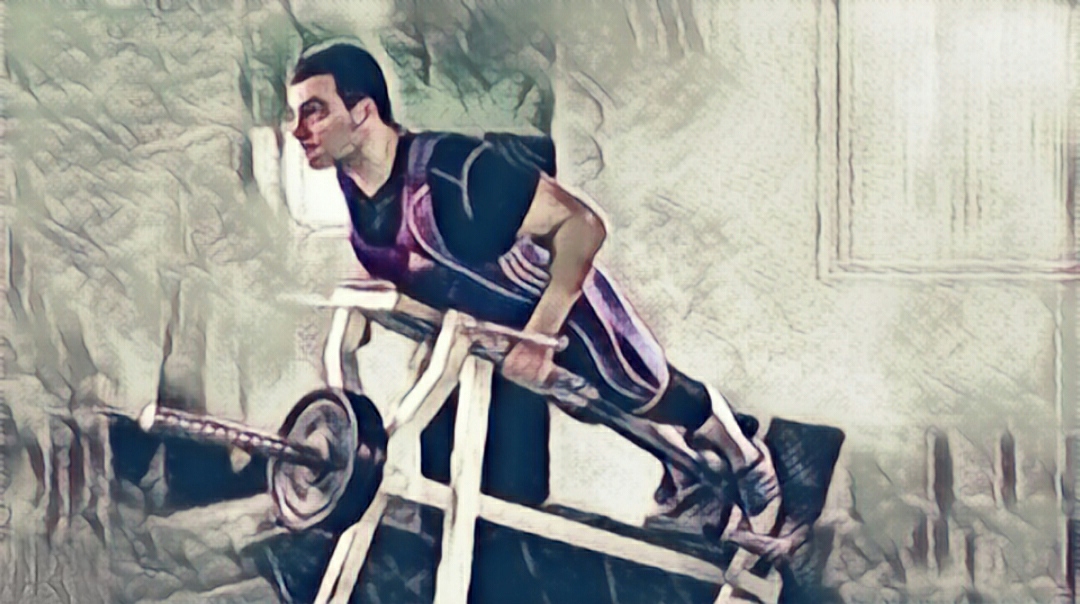
This option is popular with those who need to correct asymmetrically developed muscles, since fixing the body in the simulator allows you to evenly distribute the load, gradually leveling the muscle volume.
Arnold press with dumbbells
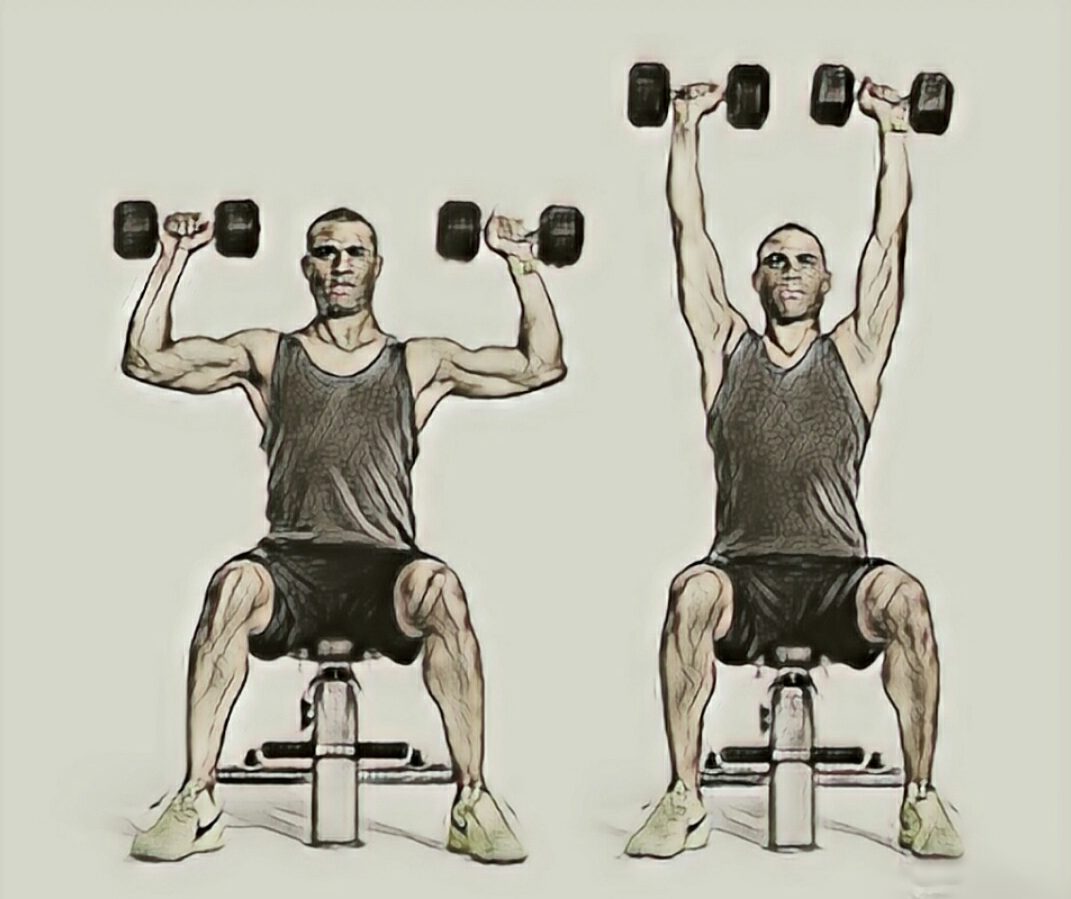
It works through all the bundles of deltas, indirectly involves the triceps. Execution technique:
- Sitting on a bench with a straight back (90 °, you can recline it one division up to 80 °) or on a chair, arms bent at the elbows hold dumbbells, the shoulder sections of the arms are slightly below parallel with the floor;
- As you exhale, the arms are turned palms forward and straightened, bringing them in line with the body;
- On inhalation, the dumbbells are lowered, the palms are again turned towards each other.
Important! The movements should be smooth, without jerks, in no case should the sensations be brought to pain. If the slightest discomfort appears, it is necessary to stop so as not to injure the shoulder joint.
Advantages:
- Qualitatively works on deltas, loads triceps well;
- Can be performed not only in the gym, but also at home.
Disadvantages:
- Contraindicated for injuries of the shoulder joints.
All options for basic exercises work effectively for both men and women, develop muscle mass and form a beautiful posture. However, it is very difficult to get beautiful relief muscles without "grinding" with isolated training. Therefore, the next step is an overview of burning workouts for the arms and back.
Dumbbell Row
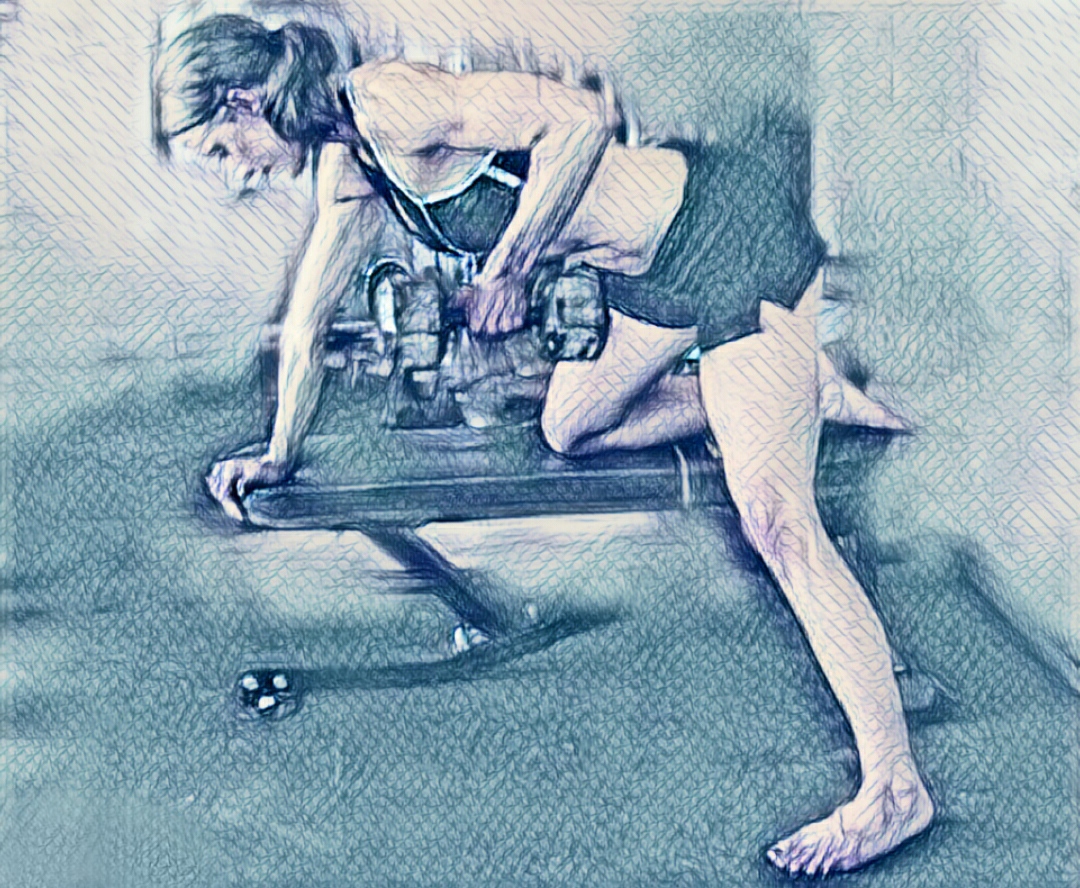
Loads the "wings" and rear deltas, works out the triceps.
Performance:
- The right knee and right hand rest on the bench, the back is straight, parallel to the floor, a dumbbell in the free lowered hand;
- On the exhale, we pull the dumbbell to the chest, on the inhale, straighten the arm.
Home option: in a squat, the free hand rests on the knee.
Important! Do not hunch down, the body is always parallel to the floor, the free shoulder should not drop. Movements are strictly controlled, there should be no jerks. When the elbow rises to shoulder level, the upward movement must be continued with the shoulder, straining the rhomboid and trapezius muscles.
Advantages:
- Works on the muscles of the back and arms;
- Minimal stress on the lumbar spine;
- Can be performed in the gym and at home.
Disadvantages:
- If done incorrectly, it loads the triceps of the arm, without working out the back.
Row to the belt in the simulator

A lightweight version of the barbell pull to the belt, allowing you to work out the muscles in detail.
Performance:
- Sitting in the simulator, there is a slight deflection in the lower back, the body is slightly tilted back;
- On the exhale, we pull the projectile to the belt, on the exhale, straighten the arms.
Important! The bent arms here are just weight holders; you need to pull the projectile with the shoulder blades.
Advantages:
- Works on the relief of the lats;
- Lighter than bent over row.
Disadvantages:
- Performed in the hall.
Hyperextension
Effective for the lumbar spine: develops muscles, strengthens the lower back. Performance:
- In a special trainer with a roller-lock for the feet, the legs and body form a straight line, the hands are locked in front of the chin or folded over the chest;
- On exhalation, tilt the body to parallel with the floor or slightly higher; on inhalation, return to its original position.
Important! Controlled movements, no body swing is allowed. You can take additional weight, such as a dumbbell or pancake, in your hands to constantly increase muscle load and progress.
Advantages:
- Loads even the deep muscles adjacent to the spinal column, which are not worked out by other trainings;
- Engages the buttocks and the back of the thighs;
- Unlike the deadlift, it is less traumatic and easier to perform.
Disadvantages:
- Cannot be done at home;
- Contraindicated for serious spinal problems, including injuries.
Home variant of hyperextension
It will look like this:
- Lying on your stomach, arms extended above your head;
- On exhalation, arms and legs are torn off the floor, after a second delay on inhalation, return to the starting position.
Important! You need to carefully monitor your feelings, at the slightest discomfort or back pain, you need to stop. Movements should be smooth, without jerking.
Advantages:
- Loads the extensors of the spine in the lumbar region;
- Partially works the buttocks.
Disadvantages:
- In terms of efficiency, it is inferior to hyperextension in the simulator.
Upper Block Row
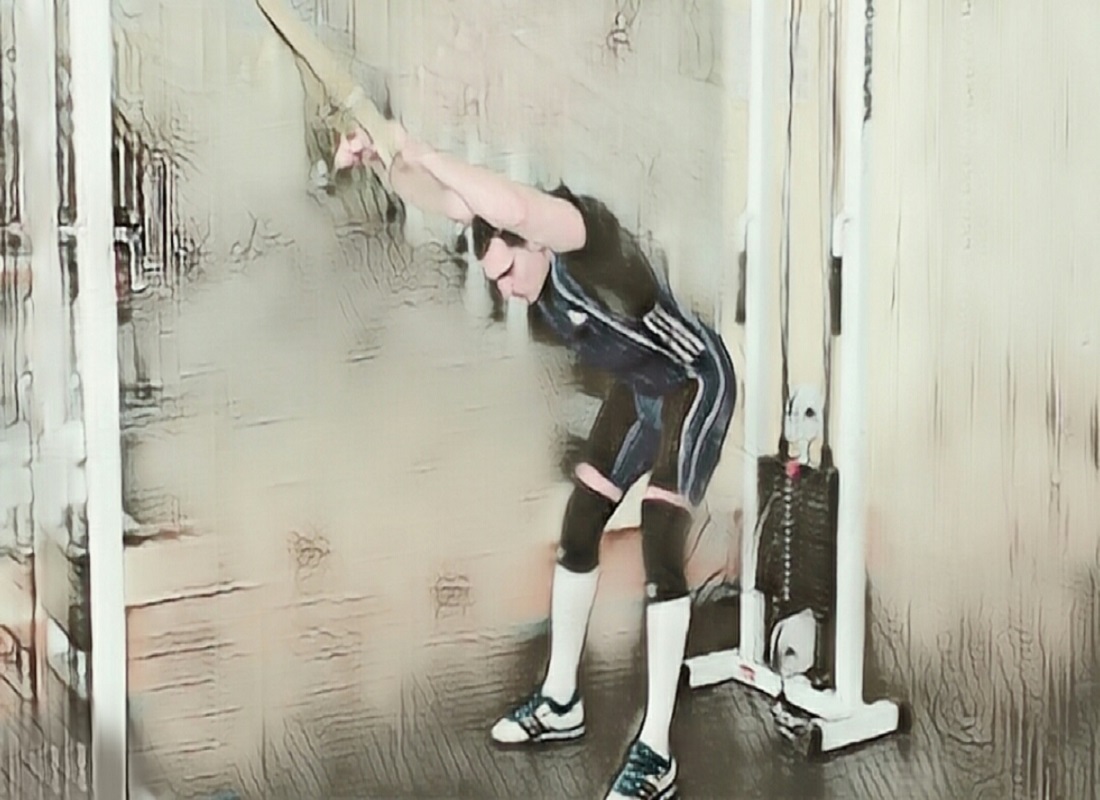
A working exercise for the muscles of the back and arms. Performance:
- Standing, feet shoulder-width apart, body and legs form an obtuse angle, in straightened arms - a projectile;
- As you exhale, we lower the projectile with straight hands to the front of the thighs, while inhaling, we return to the starting position.
Important! The downward movement should be powerful, the return to the starting position should be slow, the arms should always be straight.
Advantages:
- Loads the large round and broadest muscles;
- Engages the triceps.
Disadvantages:
- Performed only in the gym.
At the end of your workout, it is helpful to cool down to stretch your back and straighten your vertebrae. To do this, you need to hang on the horizontal bar, while exhaling, completely relaxing the body so that, under its weight, the vertebrae fall into place, and the muscles receive an additional flow of blood.
All isolated trainings can be used for losing weight and drawing muscle relief, combining them with basic trainings, you can develop and pump up a wide back and develop endurance - it all depends on the specific goal that the athlete sets for himself.
Fundamental rules
Many novice athletes are wondering how to build your back quickly, and why there is no muscle progress even with a long training period. We have prepared a list of what to look for during training to avoid mistakes:
- The ratio of weights and repetitions. The minimum number of repetitions in back exercises starts from 8, gradually it needs to be increased to 15 to strengthen and develop the muscle corset. In the future, you can increase the working weight, again reducing the number of repetitions to 8, and, reaching 15, increase the weight again. Rest between basic exercises with weights in work on the mass is from 1.5 to 2 minutes, in the intervals between approaches in isolated exercises and when drying the relief, you can rest from 1 to 1.5 minutes.
- The ratio of basic and isolated exercises. If the goal is to draw the relief, two basic and four isolated trainings will be enough. If we are talking about increasing the mass and increasing the width, there should be from 3 to 4 basic options in relation to 2-3 isolated ones.
- Frequency of training. Typically, one day a week is allocated for training a large muscle group, that is, one or another part of the body - be it the back, chest or legs, is worked out once a week. Exercises for different muscle groups of the arms are usually added to the workout of the back and chest. However, many athletes work out one muscle group twice a week, for example: on Monday they are engaged exclusively with the back and arms, and on Friday, while training the pectoral muscles, they add 2-3 back workouts to them. It all depends on the physical level of the trainee and the degree of his endurance. If the body has time to recover and progress - why not?
- Addictive effect. Basic and isolated options can be changed from time to time if you begin to notice that progress has decreased. Many athletes use this method. However, there are those who progress over the years, training according to the same training program, "playing" with the number of approaches, repetitions and working weights. It all depends on the individual characteristics of a particular athlete.
- Execution technique. If the exercise is performed incorrectly, the effect of it may not be expected at all. Therefore, you need to carefully study how this or that training is performed in order to understand its specifics.
- Mode. The main condition for success is regular training combined with proper nutrition and proper rest. No regular workouts - no muscle progress. The lack of nutrients is a guarantee that muscle mass will not grow, because the body will be forced to compensate for heavy physical exertion, recovering from the muscles, and the training will be ineffective. Not getting enough sleep and not getting enough interval between workouts will also slow your progression.
Observing these rules, even at home and with a minimum of sports equipment, you can pump up a muscular broad back and develop your arms or work out the relief and dry out, getting a beautiful, toned body that others will admire.

